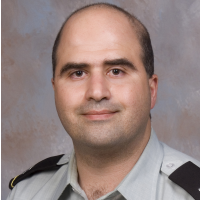Islamist Terror Threat in U.S. Shifts from Groups to Isolated Individuals
 Nidal Hasan
Nidal Hasan
The threat of a large scale Islamist terror attack in the U.S. is small today, according to a recently released report, because anti-terror efforts have disrupted and degraded the central leadership of al-Qaeda, whose followers have nonetheless created a looser network that remains capable of attacking U.S. facilities worldwide and inspiring individuals to commit isolated acts of terror.
Issued by the Homeland Security Project of the Bipartisan Policy Center, the report contrasts the situation 12 years ago, when the enemy “was clear and plainly in sight…a large terrorist organization, situated mostly in one geographic location, and led by an identifiable leader,” with today, when “the borders between domestic and international terrorism have blurred, and the United States’ adversaries are not only organizations, but also individuals.”
As the report points out, there has not been a large-scale terror attempt on the U.S. homeland since September 11, 2001, and “the total number of extremists who have been indicted has declined from 33 in 2010 to six to date in 2013, domestic terrorist incidents are relatively rare, and the character of the perpetrators has shifted from a mix of plots conducted by groups of extremists or individuals to those entirely conducted by individuals or pairs.”
Although such individual attacks, like the recent bombings at the Boston Marathon and the shootings by Major Nidal Malik Hasan at Fort Hood, Texas, typically cause relatively limited casualties, they can have a powerful psychological effect on the population nonetheless. The small number of participants can also make these plots more difficult to uncover, a difficulty sometimes outweighed by the amateurism of the would-be perpetrators.
Understanding those perpetrators, however, was clearly beyond the study authors, four politically well-connected American counter-terrorism “experts,” none of whom has earned even a single degree on the history or culture of the various Islamic peoples from which terror recruits spring.
The report acknowledges that recent lone attacks show “that even though core al-Qaeda may be in decline, ‘al-Qaeda-ism,’ the movement’s ideology, continues to resonate and attract new adherents”—but the report never defines this ideology or attempts to explain why it resonates and attracts them. Instead, it relies on vague references to anger, describing terror recruits as “disenfranchised, disillusioned, and marginalized…young ‘hot heads’ to which the core’s message has always been directed.”
Even worse, the establishment ties of the authors and their sponsoring organization prevent any discussion of those elements of U.S. foreign policy—including virtually unconditional support for Israel vis-à-vis Palestine, widespread torture and killing of locals during the U.S. wars in Afghanistan and Iraq, and alliances with repressive regimes like those in today’s Saudi Arabia or yesterday’s Egypt and Tunisia—that actually form the core complaints of militant Islamism.
The inability to knowledgeably discuss the actual tenets of militant Islamism or honestly evaluate the impact of U.S. foreign policy reflects the larger failure of the American policy class to articulate an understanding of the U.S. role in the world that makes sense of developments that are contrary to the preferences of the political leadership. Thus the report concludes with the anodyne, obvious and useless recommendation that the U.S. “needs to develop defenses against a more amorphous, diffuse threat posed by radicalized individuals while continuing to destroy and disrupt al-Qaeda and its associated groups, and the ideology that fuels and sustains them.”
Ironically, the study authors admit that they were studying the wrong problem: “According to data collected by the New America Foundation, since 2001, 29 people have been killed in politically motivated attacks by right-wing extremists in the United States, while 20 have been killed by jihadist militants.”
-Matt Bewig
To Learn More:
Jihadist Terrorism: A Threat Assessment (by Peter Bergen, Bruce Hoffman, Michael Hurley & Erroll Southers, Bipartisan Policy Center) (pdf)
- Top Stories
- Unusual News
- Where is the Money Going?
- Controversies
- U.S. and the World
- Appointments and Resignations
- Latest News
- Trump to Stop Deportations If…
- Trump Denounces World Series
- What If China Invaded the United States?
- Donald Trump Has a Mental Health Problem and It Has a Name
- Trump Goes on Renaming Frenzy






Comments